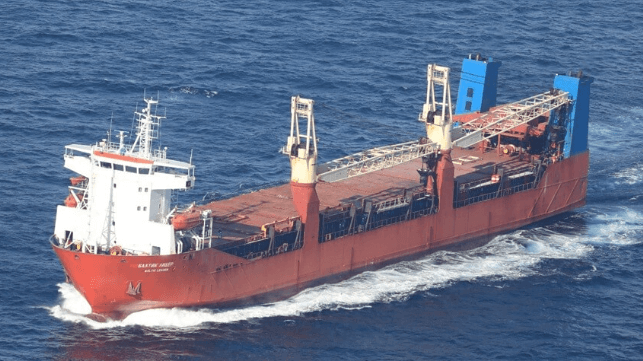Risk Rises for Russian Military Cargoes at Sea

A number of recent developments have combined to suggest that the risk to Russian military cargoes at sea has risen markedly in recent weeks. Indeed, the sinking off Oran of the Russian military cargo auxiliary Ursa Major on December 23, shortly after it had passed through the Straits of Gibraltar, may be the first manifestation of this increased threat.
The Russian war effort in Ukraine has now become highly dependent on armament shipments from abroad, given that the Russian military industry, hindered by Western sanctions and a shortage of manpower, is failing to keep up with the ammunition demands of the front line. Two of Russia’s foreign suppliers rely on seaborne freight as part of their delivery routing into Russia.
North Korea ships ammunition from its port at Raijin to Dunai near Vladivostok, where it is loaded onto the Russian rail network. Via this route, North Korea is believed to have been exporting about 300,000 122mm and 152mm shells per month, shipped in about 1,000 containers. Shipments are increasing and now include missiles and armored vehicles as well. Estimates vary, but Ukrainian Military Intelligence (GUR) believes North Korea may be providing as much as 50% of Russia’s artillery ammunition expenditure.
Iran is also supplying 122mm and 152mm ammunition shells, in lesser quantities, but its principal exports have been of drones, which have had a major impact on the battlefield. Iran cannot rely on rail routes through Azerbaijan into Chechnya, and ships through the Caspian ports of Bandar-e Anzali and Amirabad to either Kaspiysk in Dagestan or the Volga-Don transshipment port at Olaya.
On January 2, Iranian social media images (of uncertain provenance) were shown of Iranian air defense systems and truck-mounted Fath-360 tactical ballistic missiles (comparable in capability to the M142 HIMARS) at the dockside at Bandar-e Anzali prior to loading. Again, these supplies are critical to the Russian war effort.
??????????Iranian sources write that Iranian Fath-360 missile launchers and Arman air defense systems are allegedly being sent to the ????????Russian Federation with vehicles that were spotted in the port of Bandar-e Anzali on the Caspian Sea. pic.twitter.com/vfePL6UlJo
— ????MilitaryNewsUA???????? (@front_ukrainian) January 2, 2025
Fath-360 systems under tarpaulins at the Bandar-e Anzali IRISL dock facility
From the Ukrainian perspective, it is much more cost-effective to attack a concentrated cargo of munitions at sea than before they are dispersed and delivered to protected ammunition storage sites. Moreover, Ukraine has demonstrated that it has no compunction in attacking Russian targets outside Russia.
Putting aside any attribution of the attack on the Ursa Major in the Straits of Gibraltar through lack of any evidence, Ukraine is believed to have had technical and material input in operations against Russian Africa Corps mercenaries deployed in Sudan, Niger and Mali, and is reported to have provided drone assistance to HTS forces in their victorious campaign in Syria. By mounting drone attacks on Russian naval vessels Tatarstan (F691) and Dagestan (F693) in Kaspiysk on November 6, the Ukrainians have already demonstrated a capability to attack shipping in the Caspian Sea.
Mounting attacks on any of these sea routes – and potentially on the imminent sea evacuation of Russian military equipment from Tartus - would be a high priority, but technically challenging. Nevertheless, the Ukrainians have a well-proven capacity to field ingenious solutions to such complex military requirements, and this particular challenge would offer a high-value return on the resource investment necessary. Moreover, an increasing number of nations may be willing to provide covert technical assistance and support to the Ukrainians in such endeavors, now that evidence is emerging that the Russians themselves may be orchestrating covert attacks on seabed cables in the Baltic.
The opinions expressed herein are the author's and not necessarily those of The Maritime Executive.
